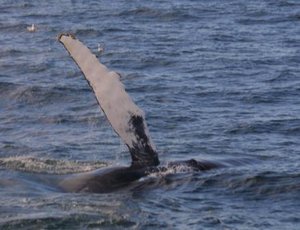Whale behaviour
|
|
Whales exhibit various types of physical behaviour when they surface. This article describes the different behaviours commonly observed at sea and the possible reasons for the behaviour.
| Contents |
Breaching, lunging and porpoising
A breach or a lunge is a leap out of the water. The act of leaping generates more power than any other act performed by a non-human animal. The distinction between the two is fairly arbitrary. Cetacean researcher Hal Whitehead chooses to define a breach as any leap in which 40% of the animal's body clears the water, and a lunge as a leap with less than 40% clearance. More qualitatively, a breach is a genuine jump with an intent to clear the water as much as possible, whereas a lunge is the result of a fast upward sloping swim, perhaps as a result of feeding, that has caused the whale to clear the surface of the water by accident.
Some whales, such as Sperm Whales, perform a breach by travelling vertically upwards from depth, and heading straight out of the water. Others, such as the Humpback Whale, travel close to the surface and parallel to it, and then jerk upwards at full speed to perform a breach. In a typical breach, as performed by a Humpback or Right Whale, the whale clears the water at an angle of about 30° to the horizontal. Around 90% of the body clears the water before the whale turns to land on its back or side. "Belly flops" also occur but are less common. In order to achieve 90% clearance, a Humpback needs to leave the water at a speed of eight metres per second. This is close to the whale's maximum speed. It is supposed that other species are also at their limit of power.
Breaches are often carried out in sessions. The longest sustained series of breaches ever recorded was by a Humpback Whale in the waters around the West Indies - 130 separate leaps were recorded in less than 90 minutes. As a whale repeatedly breaches, it typically becomes steadily more tired, and less of the body clears the water.
The Right Whales, Humpback and Sperms are the most prodigious jumpers. However the other baleen whales such as the Fin, Blue, Minke and Sei also breach but not on such a regular basis. Marine dolphins, including the Orca, are all very common breachers and in fact capable of lifting themselves completely out of the water very easily.
Scientists do not really know why whales breach. However many possible reasons have been suggested. First, it has been observed that whales are more likely to breach when they are in groups, suggesting that social reasons, such as dominance or communication may be part of the answer. Scientists have called this theory a sign of "honest signalling". The immense cloud of bubbles and underwater disturbance caused by a breach cannot be faked. Thus if neighbours detect these bubbles then they know a breach has taken place and, because a single breach costs a whale about 1% of its total daily energy intake, the breach is not to be taken lightly. Whether the breacher is asserting its strength over another, courting a mate or warning of a danger, a breach is in these circumstances is an event to be taken seriously.
It is also possible that the loud "smack" upon re-entering the surface is useful for stunning or scaring fish. Certainly this is believed to be the reason for lobtailing. Others have suggested that a breach allows the whale to breathe in air that is not close to the surface of the water, and so may aid breathing in rough seas. A widely accepted possible reason is to remove parasites from the skin.
Spyhopping
Spyhopping is the act of coming out of the water vertically and momentarily staying out of the water in a manner akin to a human treading water. A powerful individual can spyhop as much as half of its body out of the water. The reasons for spyhopping are likely to be similar to those of breaching. Further spyhops may well be used so that the whale can examine its surroundings above the surface — for instance to look at boats. For this a spyhop may be more useful than a breach, because the view is held steady for longer.
Lobtailing and slapping
Lobtailing is the act of a whale or dolphin lifting their tail fluke out of the water and then bringing it down onto the surface of the water hard and fast in order to make a loud slap. Similarly, species with large flippers may also slap them against the water.
Whale_tail_flip.jpg
Like breaching, lobtailing is common amongst active cetacean species such as Sperm, Humpback, Right and Gray Whales. It is less common, but still occasionally occurs, amongst the other large whales. Porpoises and river dolphins rarely lobtail, but it is a very common phenomenon amongst oceanic dolphins. It seems that lobtailing is more common within species that have a complex social order than those where animals are more likely to be solitary.
Large whales tend to lobtail by positioning themselves vertically downwards into the water and then slapping the surface by bending the tail stock. Dolphins, however, tend to remain horizontal and make the slap via a jerky whole body movement. All species are likely to slap several times in a single session. The sound of a lobtail can be heard underwater several hundred metres from the site of a slap. This has led to speculation amongst scientists that lobtailing is, like breaching, a form of non-vocal communication. However studies of Bowhead Whales have shown that the noise of a lobtail travels much less well than that of a vocal call or a breach. Thus the lobtail is probably important visually as well as acoustically, and may be a sign of aggression.
Weinrich, Schilling and Belt (1992) suggest that lobtailing in Humpback Whales is a means of foraging. The theory is that the loud noise cause fish to become frightened, thus tightening their school together, making it easier for the Humpback to feed on them.
References
- Evidence for acquistion of a novel feeding behavior: Lobtailing in Humpback Whales, Weinrich, Schilling and Belt. Animal Behaviour. 44 1059-1072 (1992).
- Feeding, aerial and play behavior of the Bowhead Whale, Wursig, Dorsey, Richardson and Wells, Aquatic Mammals, 15, 27-37 (1989).



